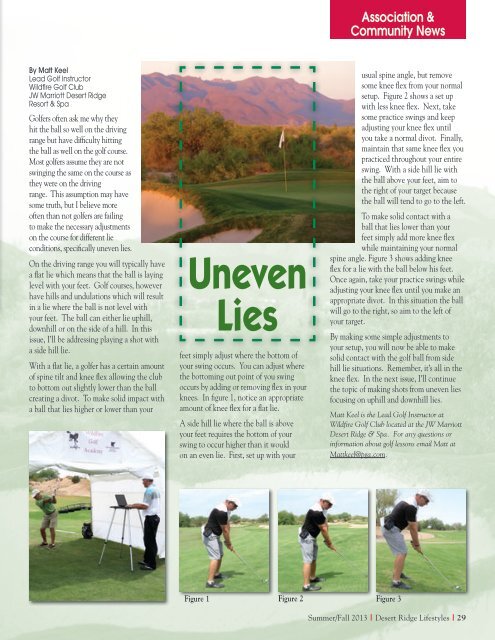Summer-Fall 2013
You also want an ePaper? Increase the reach of your titles
YUMPU automatically turns print PDFs into web optimized ePapers that Google loves.
Association &<br />
Community News<br />
By Matt Keel<br />
Lead Golf Instructor<br />
Wildfire Golf Club<br />
JW Marriott Desert Ridge<br />
Resort & Spa<br />
Golfers often ask me why they<br />
hit the ball so well on the driving<br />
range but have difficulty hitting<br />
the ball as well on the golf course.<br />
Most golfers assume they are not<br />
swinging the same on the course as<br />
they were on the driving<br />
range. This assumption may have<br />
some truth, but I believe more<br />
often than not golfers are failing<br />
to make the necessary adjustments<br />
on the course for different lie<br />
conditions, specifically uneven lies.<br />
On the driving range you will typically have<br />
a flat lie which means that the ball is laying<br />
level with your feet. Golf courses, however<br />
have hills and undulations which will result<br />
in a lie where the ball is not level with<br />
your feet. The ball can either lie uphill,<br />
downhill or on the side of a hill. In this<br />
issue, I’ll be addressing playing a shot with<br />
a side hill lie.<br />
With a flat lie, a golfer has a certain amount<br />
of spine tilt and knee flex allowing the club<br />
to bottom out slightly lower than the ball<br />
creating a divot. To make solid impact with<br />
a ball that lies higher or lower than your<br />
Uneven<br />
Lies<br />
feet simply adjust where the bottom of<br />
your swing occurs. You can adjust where<br />
the bottoming out point of you swing<br />
occurs by adding or removing flex in your<br />
knees. In figure 1, notice an appropriate<br />
amount of knee flex for a flat lie.<br />
A side hill lie where the ball is above<br />
your feet requires the bottom of your<br />
swing to occur higher than it would<br />
on an even lie. First, set up with your<br />
usual spine angle, but remove<br />
some knee flex from your normal<br />
setup. Figure 2 shows a set up<br />
with less knee flex. Next, take<br />
some practice swings and keep<br />
adjusting your knee flex until<br />
you take a normal divot. Finally,<br />
maintain that same knee flex you<br />
practiced throughout your entire<br />
swing. With a side hill lie with<br />
the ball above your feet, aim to<br />
the right of your target because<br />
the ball will tend to go to the left.<br />
To make solid contact with a<br />
ball that lies lower than your<br />
feet simply add more knee flex<br />
while maintaining your normal<br />
spine angle. Figure 3 shows adding knee<br />
flex for a lie with the ball below his feet.<br />
Once again, take your practice swings while<br />
adjusting your knee flex until you make an<br />
appropriate divot. In this situation the ball<br />
will go to the right, so aim to the left of<br />
your target.<br />
By making some simple adjustments to<br />
your setup, you will now be able to make<br />
solid contact with the golf ball from side<br />
hill lie situations. Remember, it’s all in the<br />
knee flex. In the next issue, I’ll continue<br />
the topic of making shots from uneven lies<br />
focusing on uphill and downhill lies.<br />
Matt Keel is the Lead Golf Instructor at<br />
Wildfire Golf Club located at the JW Marriott<br />
Desert Ridge & Spa. For any questions or<br />
information about golf lessons email Matt at<br />
Mattkeel@pga.com.<br />
Figure 1<br />
Figure 2 Figure 3<br />
<strong>Summer</strong>/<strong>Fall</strong> <strong>2013</strong> Desert Ridge Lifestyles 29






